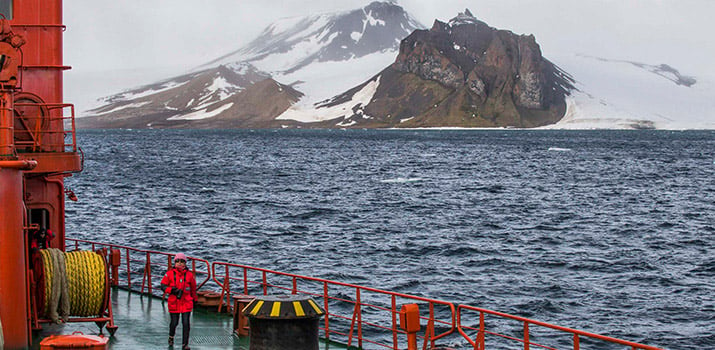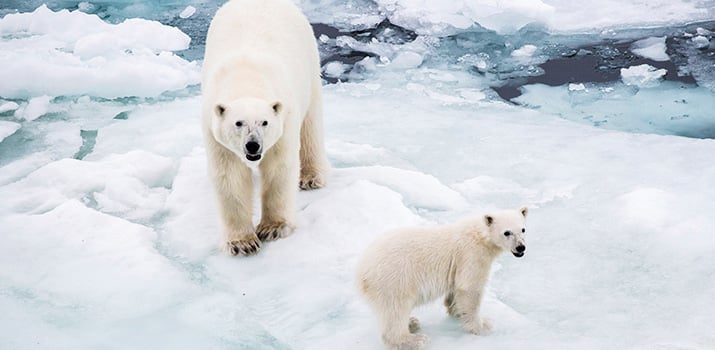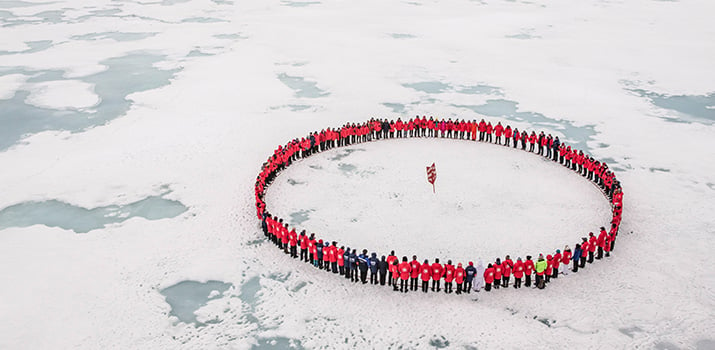What's the Difference Between the Arctic and Antarctica?

The Arctic and Antarctica might seem quite similar at first glance: Mountainous, snow-covered landscapes and icebergs, whales, and nesting seabirds by the tens of thousands. But they are polar opposites – literally – and in many other ways you might not expect.
The Arctic vs. The Antarctic
History & Exploration
While Captain James Cook and his crew crossed the Antarctic Circle in 1773, they didn't set foot on or even see the continent itself. January 19, 1840, marked the first time in recorded history that people walked on the southern-most continent when Charles Wilkes led a fleet of six ships from Virginia to Australia to Antarctica over the course of two years.
Early exploration of the Arctic started in the 1590s when European monarchs began their search for an alternate trading route to China. William Barents, a Dutch explorer, made three voyages in search of a passage and eventually discovered Spitsbergen. During his third and final voyage, his ship became trapped by sea ice, forcing Barents and his crew to spend the winter in the High Arctic. Barents died during the trip home, but many of his crew survived. It would be many years – and many explorations – before Roald Amundsen would complete the first successful voyage through the Northwest Passage, from 1903-1905. The North Pole was discovered in 1909 by Robert E. Peary. It took Peary eight attempts over the course of 23 years.
However, Peary's discovery in 1909 was followed by news that Dr. Frederic A. Cook had actually reached the North Pole in 1908. However, to this day, neither claim has been confirmed – or disproven – and both men are credited with being important Arctic explorers.
Terrain
The terrain of the Arctic and Antarctica holds some major differences, most notably at the Poles themselves. While Antarctica is an actual continent (the fifth largest), there is no land at the North Pole, only sea ice.
Think of it this way: the Arctic is an ocean that is almost completely surrounded by land; Antarctica is land, completely surrounded by an ocean.
The North Pole is at sea level, and Antarctica has the highest average elevation of all the continents on the planet, with the continent's highest peak at 16,066 feet. Antarctica also stands apart thanks to its two volcanoes – Mount Erebus and Deception Island.
Ice
According to the National Snow & Ice Data Center, the different settings on these two extreme locations create very different ice conditions. In the Arctic, sea ice floes are prone to bump into each other, forming thicker ice and ridges - some up to 12 to 15 feet thick. "Of the 5.8 million square miles of sea ice that exist during winter, on average, 2.7 million square miles remain at the end of the summer melt season," the NSIDC states.
Open waters around Antarctica create conditions where ice can roam freely. This results in thinner ice – usually around three to six feet thick – and more ice melt during the summer. According to the NSIDC, during the winter, up to 6.9 million square miles of ocean is covered by sea ice, but by the end of summer, only about 1.1 million square miles of sea ice remains.
Wildlife & Nature
Flora and fauna are very different at the Poles. In the Arctic, land mammals such as polar bears, Arctic fox, Arctic reindeer, and Arctic hare are prevalent. Antarctica isn't home to any large land mammals whatsoever.

The Arctic is also home to walruses and puffins - neither of which are found in Antarctica. The Arctic also boasts much more flora – nearly 1,500 difference species – than its icy southern counterpart.
Despite its lack of plant life, Antarctica is home to many species of animals including seals, whales, and many different kinds of penguins, such as gentoos, king penguins, and emperor penguins.
Seasons & Climate
Being on opposite ends of the Earth means opposite seasons, though both regions encounter long, cold winters and short, cool summers. Antarctica is colder than the Arctic and claims the coldest air temperature ever recorded on Earth: -128F (-88ºC).Austral Summer, at the Earth's southernmost point, runs from November through February. December and January are the months with the most sunlight (up to 20 hours a day), and daily temperatures are at their warmest. In January, temperatures at the Peninsula average 34ºF (1ºC). Mid-December is the time when penguins begin hatching their chicks. Antarctica is covered with ice (and contains more than 90 percent of the Earth's ice) but, it Is technically a desert and one of the driest places on Earth. It is also one of the windiest - with wind speeds reaching 200MPH.
In the Arctic, temperatures range from -40ºF (-40ºC) in the winter to as high as 50ºF (10ºC), during the summer In addition to warmer temperatures, Arctic summers, which runs from June through September, also offer the Midnight Sun. Depending on the weather, sunlight, or at least a lighted sky is prevalent 18-24 hours per day. The midnight sun also contributes to the warmer temperatures, melting the sea ice. Of course, in the winter, nighttime lasts for six months.
Ownership
Many countries have research facilities in Antarctica, but the continent belongs to no one, and many international treaties are in place to protect the land. No single country owns the North Pole, either.
Not sure which polar destination is right for you? Download the Poseidon Expeditions brochure to get complete details on all of our Antarctic and Arctic expedition cruises.
